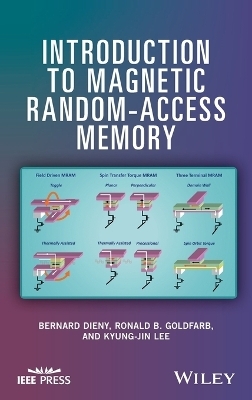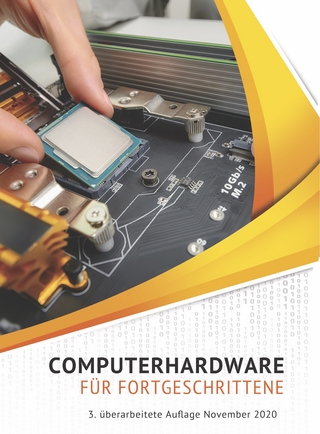
Introduction to Magnetic Random-Access Memory
Wiley-IEEE Press (Verlag)
9781119009740 (ISBN)
This book is an introduction to MRAM for microelectronics engineers written by specialists in magnetic materials and devices. It presents the basic phenomena involved in MRAM, the materials and film stacks being used, the basic principles of the various types of MRAM (toggle and spin-transfer torque; magnetized in-plane or perpendicular-to-plane), the back-end magnetic technology, and recent developments toward logic-in-memory architectures. It helps bridge the cultural gap between the microelectronics and magnetics communities.
Bernard Dieny has conducted research in magnetism for 30 years. He played a key role in the pioneering work on spin-valves at IBM Almaden Research Center in 1990-1991. In 2001, he co-founded SPINTEC in Grenoble, France, a public research laboratory devoted to spin-electronic phenomena and components. Dieny is co-inventor of 70 patents and has co-authored more than 340 scientific publications. He received an outstanding achievement award from IBM in 1992 for the development of spin-valves, the European Descartes Prize for Research in 2006, and two Advanced Research Grants from the European Research Council in 2009 and 2015. He is co-founder of two companies, one dedicated to magnetic random-access memory, Crocus Technology, the other to the design of hybrid CMOS/magnetic circuits, EVADERIS. In 2011 he was elected Fellow of the Institute of Electrical and Electronics Engineers. Ronald B. Goldfarb was leader of the Magnetics Group at the National Institute of Standards and Technology in Boulder, Colorado, USA, from 2000 to 2015. He has published over 60 papers, book chapters, and encyclopedia articles in the areas of magnetic measurements, superconductor characterization, and instrumentation. In 2004 he was elected Fellow of the Institute of Electrical and Electronics Engineers (IEEE). From 1995 to 2004 he was editor in chief of IEEE Transactions on Magnetics. He is the founder and chief editor of IEEE Magnetics Letters, established in 2010. He received the IEEE Magnetics Society Distinguished Service Award in 2016. Kyung-Jin Lee is a professor in the Department of Materials Science and Engineering, and an adjunct professor of the KU-KIST Graduate School of Converging Science and Technology, at Korea University. Before joining the university, he worked for Samsung Advanced Institute of Technology in the areas of magnetic recording and magnetic random-access memory. His current research is focused on understanding the underlying physics of current-induced magnetic excitations and exploring new spintronic devices utilizing spin-transfer torque. He is co-inventor of 20 patents and has more than 100 scientific publications in the areas of magnetic random-access memory, spin-transfer torque, and spin-orbit torques. He received an outstanding patent award from the Korea Patent Office in 2005 and an award for Excellent Research on Basic Science from the Korean government in 2010. In 2013 he was recognized by the National Academy of Engineering of Korea as a leading scientist in spintronics, "one of the top 100 technologies of the future."
About the Editors xi
Preface A Perspective on Nonvolatile Magnetic Memory Technology xiii
Chapter 1 Basic Spintronic Transport Phenomena 1
Nicolas Locatelli and Vincent Cros
1.1 Giant Magnetoresistance 2
1.1.1 Basics of Electronic Transport in Magnetic Materials 2
1.1.2 A Simple Model to Describe GMR: The “Two-Current Model” 5
1.1.3 Discovery of GMR and Early GMR Developments 7
1.1.4 Main Applications of GMR 8
1.2 Tunneling Magnetoresistance 9
1.2.1 Basics of Quantum Mechanical Tunneling 10
1.2.2 First Approach to Tunnel Magnetoresistance: Jullière’s Model 11
1.2.3 The Slonczewski Model 14
1.2.3.1 The Model 14
1.2.3.2 Experimental Observations 15
1.2.3.3 About the TMR Angular Dependence 15
1.2.4 More Complex Models: The Spin Filtering Effect 16
1.2.4.1 Incoherent Tunneling Through an Amorphous (Al2O3) Barrier 16
1.2.4.2 Coherent Tunneling Through a Crystalline MgO Barrier 17
1.2.5 Bias Dependence of Tunnel Magnetotransport 19
1.3 The Spin-Transfer Phenomenon 20
1.3.1 The Concept and Origin of the Spin-Transfer Effect 20
1.3.1.1 The “In-Plane” Torque 20
1.3.1.2 The “Out-of-Plane” Torque 23
1.3.2 Spin-Transfer-Induced Magnetization Dynamics 23
1.3.2.1 A Simple Analogy 24
1.3.2.2 Toward MRAM Based on Spin-Transfer Torque 25
1.3.3 Main Events Concerning Spin-Transfer Advances 26
References 27
Chapter 2 Magnetic Properties of Materials for Mram 29
Shinji Yuasa
2.1 Magnetic Tunnel Junctions for MRAM 29
2.2 Magnetic Materials and Magnetic Properties 31
2.2.1 Ferromagnet and Antiferromagnet 31
2.2.2 Demagnetizing Field and Shape Anisotropy 33
2.2.3 Magnetocrystalline Anisotropy, Interface Magnetic Anisotropy, and Perpendicular Magnetic Anisotropy 35
2.2.4 Exchange Bias 36
2.2.5 Interlayer Exchange Coupling and Synthetic Antiferromagnetic Structure 37
2.2.6 Spin-Valve Structure 38
2.3 Basic Materials and Magnetotransport Properties 39
2.3.1 Metallic Nonmagnetic Spacer for GMR Spin-Valve 39
2.3.2 Magnetic Tunnel Junction with Amorphous AlO Tunnel Barrier 41
2.3.3 Magnetic Tunnel Junction with Crystalline MgO(0 0 1) Tunnel Barrier 44
2.3.3.1 Epitaxial MTJ with a Single-Crystal MgO(0 0 1) Barrier 44
2.3.3.2 CoFeB/MgO/CoFeB MTJ with a (0 0 1)-Textured MgO Barrier for Device Applications 46
2.3.3.3 Device Applications of MgO-Based MTJs 48
References 51
Chapter 3 Micromagnetism Applied to Magnetic Nanostructures 55
Liliana D. Buda-Prejbeanu
3.1 Micromagnetic Theory: From Basic Concepts Toward the Equations 55
3.1.1 Free Energy of a Magnetic System 56
3.1.1.1 Exchange Energy 56
3.1.1.2 Magnetocrystalline Anisotropy Energy 57
3.1.1.3 Demagnetizing Energy 57
3.1.1.4 Zeeman Energy 60
3.1.2 Magnetically Stable State and Equilibrium Equations 61
3.1.3 Equations of Magnetization Motion 62
3.1.4 Length Scales in Micromagnetism 63
3.1.5 Modification Related to Spin-Transfer Torque Phenomena and Spin–Orbit Coupling 64
3.1.6 Thermal Fluctuations 65
3.1.7 Numerical Micromagnetism 66
3.2 Micromagnetic Configurations in Magnetic Circular Dots 67
3.3 STT-Induced Magnetization Switching: Comparison of Macrospin and Micromagnetism 70
3.4 Example of Magnetization Precessional STT Switching: Role of Dipolar Coupling 73
References 76
Chapter 4 Magnetization Dynamics 79
William E. Bailey
4.1 Landau–Lifshitz–Gilbert Equation 79
4.1.1 Introduction 79
4.1.2 Variables in the Equation 80
4.1.3 The Equation 81
4.1.3.1 Precessional Term 82
4.1.3.2 Relaxation Term 83
4.2 Small-Angle Magnetization Dynamics 84
4.2.1 LLG for Thin-Film, Magnetized in Plane, Small Angles 84
4.2.2 Ferromagnetic Resonance 85
4.2.3 Tabulated Materials Parameters 87
4.2.3.1 Bulk Values 87
4.2.3.2 Finite-Size Effects 88
4.2.4 Pulsed Magnetization Dynamics 89
4.3 Large-Angle Dynamics: Switching 90
4.3.1 Quasistatic Limit: Stoner–Wohlfarth Model 90
4.3.2 Thermally Activated Switching 93
4.3.3 Switching Trajectory 94
4.4 Magnetization Switching by Spin-Transfer 95
4.4.1 Additional Terms to the LLG 95
4.4.2 Full-Angle LLG with Spin-Torque 96
Acknowledgments 97
References 97
Chapter 5 Magnetic Random-access Memory 101
Bernard Dieny and I. Lucian Prejbeanu
5.1 Introduction to Magnetic Random-Access Memory (MRAM) 101
5.1.1 Historical Perspective 101
5.1.2 Various Categories of MRAM 102
5.2 Storage Function: MRAM Retention 104
5.2.1 Key Role of the Thermal Stability Factor 104
5.2.2 Thermal Stability Factor for In-Plane and Out-of-Plane Magnetized Storage Layer 106
5.3 Read Function 110
5.3.1 Principle of Read Operation 110
5.3.2 STT-Induced Disturbance of the Storage Layer Magnetic State During Read 111
5.4 Field-Written MRAM (FIMS-MRAM) 112
5.4.1 Stoner–Wohlfarth MRAM 112
5.4.2 Toggle MRAM 115
5.4.2.1 Toggle Write Principle 115
5.4.2.2 Improved Write Margin 117
5.4.2.3 Applications of Toggle MRAM 117
5.4.3 Limitation in Downsize Scalability 118
5.5 Spin-Transfer Torque MRAM (STT-MRAM) 118
5.5.1 Principle of STT Writing 119
5.5.2 Considerations of Breakdown, Write, Read Voltage Distributions 122
5.5.3 Influence of STT Write Pulse Duration 123
5.5.4 In-Plane STT-MRAM 124
5.5.4.1 Critical Current for Switching 124
5.5.4.2 Minimization of Critical Current for Writing 125
5.5.5 Out-of-Plane STT-MRAM 128
5.5.5.1 Benefit of Out-of-Plane Configuration in Terms of Write Current 130
5.5.5.2 Trade-off Between Strong Perpendicular Anisotropy and Low Gilbert Damping 131
5.5.5.3 Benefit from Magnetic Metal/Oxide Perpendicular Anisotropy 131
5.5.5.4 Downsize Scalability of Perpendicular STT-MRAM 133
5.6 Thermally-Assisted MRAM (TA-MRAM) 135
5.6.1 Trade-off Between Retention and Writability; General Idea of Thermally-Assisted Writing 135
5.6.2 Self-Heating in MTJ Due to High-Density Tunneling Current 136
5.6.3 In-Plane TA-MRAM 136
5.6.3.1 Write Selectivity Due to a Combination of Heating and Field 136
5.6.3.2 Reduced Power Consumption, Thanks to Low Write Field and Field Sharing 138
5.6.4 TA-MRAM with Soft Reference: Magnetic Logic Unit (MLU) 140
5.6.4.1 Principle of Reading with Soft Reference 141
5.6.4.2 Content-Addressable Memory 143
5.6.5 Thermally-Assisted STT-MRAM 144
5.6.5.1 In-Plane STT Plus TA-MRAM 144
5.6.5.2 Out-of-Plane STT Plus TA-MRAM 145
5.7 Three-Terminal MRAM Devices 150
5.7.1 Field versus Current-Induced Domain Wall Propagation 150
5.7.2 Principle of Writing 152
5.7.3 Advantages and Drawbacks of Three-Terminal Devices 153
5.8 Comparison of MRAM with Other Nonvolatile Memory Technologies 153
5.8.1 MRAM in the International Technology Roadmap for Semiconductors (ITRS) 153
5.8.2 Comparison of MRAM and Redox-RAM 155
5.8.3 Main Applications of MRAM 155
5.9 Conclusion 157
Acknowledgments 157
References 158
Chapter 6 Magnetic Back-end Technology 165
Michael C. Gaidis
6.1 Magnetoresistive Random-Access Memory (MRAM) Basics 165
6.2 MRAM Back-End-of-Line Structures 166
6.2.1 Field-MRAM 166
6.2.2 Spin-Transfer Torque (STT) MRAM 168
6.2.3 Other Magnetic Memory Device Structures 169
6.3 MRAM Process Integration 169
6.3.1 The Magnetic Tunnel Junction 169
6.3.1.1 Substrate Preparation 171
6.3.1.2 Film Deposition and Anneal 172
6.3.1.3 Device Patterning 174
6.3.1.4 Dielectric Encapsulation 179
6.3.2 Wiring and Packaging 183
6.3.2.1 Ferromagnetic Cladding 184
6.3.2.2 Packaging 186
6.3.3 Processing Cost Considerations 186
6.4 Process Characterization 187
6.4.1 200–300 mm Wafer Blanket Magnetic Films 187
6.4.1.1 Current-in-Plane Tunneling (CIPT) 188
6.4.1.2 Kerr Magnetometry 189
6.4.2 Parametric Test of Integrated Magnetic Devices 189
6.4.2.1 Magnetoresistance versus Resistance and Resistance versus Reciprocal Area 190
6.4.2.2 Breakdown Voltage 192
6.4.2.3 Device Spreads 194
Acknowledgments 195
References 195
Chapter 7 Beyond Mram: Nonvolatile Logic-in-memory Vlsi 199
Takahiro Hanyu, Tetsuo Endoh, Shoji Ikeda, Tadahiko Sugibayashi, Naoki Kasai, Daisuke Suzuki, Masanori Natsui, Hiroki Koike, and Hideo Ohno
7.1 Introduction 199
7.1.1 Memory Hierarchy of Electronic Systems 199
7.1.2 Current Logic VLSI: The Challenge 201
7.2 Nonvolatile Logic-in-Memory Architecture 203
7.2.1 Nonvolatile Logic-in-Memory Architecture Using Magnetic Flip-Flops 205
7.2.2 Nonvolatile Logic-in-Memory Architecture Using MTJ Devices in Combination with CMOS Circuits 207
7.3 Circuit Scheme for Logic-in-Memory Architecture Based on Magnetic Flip-Flop Circuits 209
7.3.1 Magnetic Flip-Flop Circuit 209
7.3.2 M-Latch 211
7.4 Nonvolatile Full Adder Using MTJ Devices in Combination with MOS Transistors 214
7.5 Content-Addressable Memory 217
7.5.1 Nonvolatile Content-Addressable Memory 217
7.5.2 Nonvolatile Ternary CAM Using MTJ Devices in Combination with MOS Transistors 220
7.6 MTJ-based Nonvolatile Field-Programmable Gate Array 224
References 227
Appendix Units for Magnetic Properties 231
Index 233
| Sprache | englisch |
|---|---|
| Maße | 160 x 236 mm |
| Gewicht | 567 g |
| Themenwelt | Informatik ► Weitere Themen ► Hardware |
| Naturwissenschaften ► Physik / Astronomie ► Festkörperphysik | |
| Technik ► Elektrotechnik / Energietechnik | |
| ISBN-13 | 9781119009740 / 9781119009740 |
| Zustand | Neuware |
| Informationen gemäß Produktsicherheitsverordnung (GPSR) | |
| Haben Sie eine Frage zum Produkt? |
aus dem Bereich


